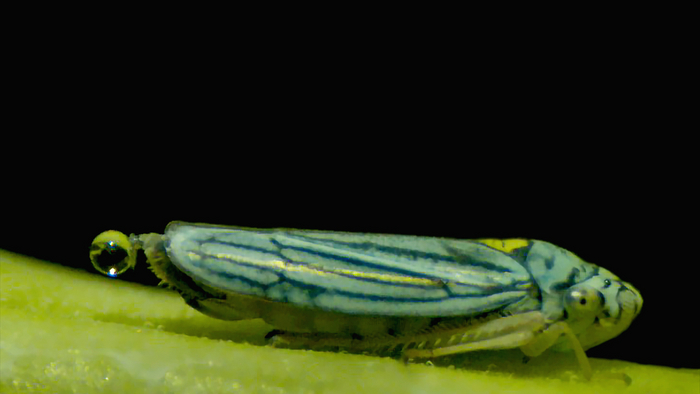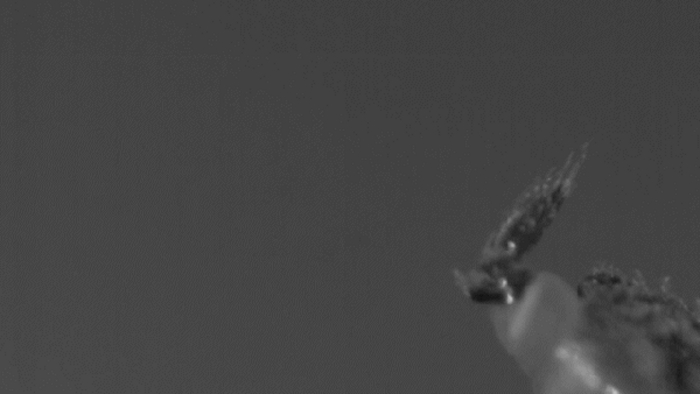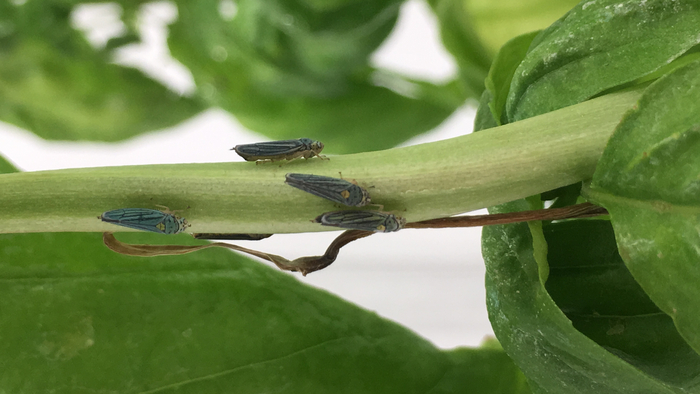Insect that flings pee with a butt catapult is 1st known example of 'superpropulsion' in nature
Glassy-winged sharpshooters rapidly fire their pee out of butt catapults.

Relatives of cicadas known as sharpshooter insects can catapult pee droplets at superfast speeds, revealing the first known example of "superpropulsion" in nature, a new study finds.
This newly discovered effect helps the bugs save energy during peeing and may inspire better self-cleaning devices and soft robotic engines, scientists noted.
In the new study, researchers examined relatives of cicadas known as glassy-winged sharpshooters (Homalodisca vitripennis). These insects, which are about half an inch (1.2 centimeters) long, feed on sap from xylem, the woody part of a plant that brings water and dissolved nutrients up from the roots, as opposed to the phloem, which brings sugar down from the leaves.
The sharpshooter's diet is 95% water, and poor in nutrients. So the bugs constantly drink xylem sap to get enough to eat, and pee up to 300 times their body weight per day. (For comparison, humans pee about one-fortieth of their body weight per day.)
Although much is known about the mechanics of eating, a great deal remains unknown about the physics of excretion, the researchers noted. They focused on sharpshooters to see if their small bodies evolved any clever innovations to contend with constantly peeing "leafhopper rain."
Related: The weird reason dolphins drink each other’s pee

"I saw these insects peeing once and fell in love," study senior author Saad Bhamla, a biophysicist at the Georgia Institute of Technology in Atlanta, told Live Science.
Sign up for the Live Science daily newsletter now
Get the world’s most fascinating discoveries delivered straight to your inbox.
The scientists used high-speed videos and microscopy to analyze a structure at the sharpshooter's tail end, technically named the anal stylus, or as Bhamla called it, a "butt flicker." When the bug is ready to pee, the stylus flexes downward to make room as the bug squeezes out a droplet of urine. When the drop reaches an optimal size, the stylus bends downward even more and then, like the flippers of a pinball machine, launches the droplet, accelerating more than 40 g's — 10 times higher than the fastest sports cars.
The researchers found that the stylus travels at up to 0.75 feet per second (0.23 meters per second). However, the catapulted droplets fly about 40% faster, at up to 1.05 feet per second (0.32 m/s).
The discovery reveals that an effect called superpropulsion, previously seen only in artificial settings, is happening. With superpropulsion, an elastic projectile moves faster than its launchpad does because of an energy boost it receives from syncing its motions with that of its launchpad, like a diver timing their jump off a springboard.
Specifically, the scientists found that the stylus compressed the droplets, storing energy in their surface tension just before launch to help catapult them at high speeds. Surface tension is the force that compels drops of liquid to bead up, and it results from how tightly the molecules in liquids stick to one another as opposed to something else, making the surfaces of liquids act like flexible membranes.
"Oftentimes we overlook excretion because it's taboo or silly, but it's a critical biological function akin to feeding that has important energetic, ecological and evolutionary implications," study first author Elio Challita, a biophysicist at the Georgia Institute of Technology, told Live Science. "What started as a curious observation of an unusual peeing mechanism uncovered the first example of superpropulsion in a biological organism."

To see why sharpshooters catapulted pee droplets instead of spraying urine in jets, the researchers used micro-CT scans to analyze the bugs' anatomy and take measurements from inside the insects. This helped the team calculate the pressure and energy the insects needed for peeing, revealing that superpropulsion demanded four to eight times less energy than jets did.
These findings may help engineers build devices that can clean themselves with less energy. "Water droplets often stick to surfaces due to surface tension, which can be undesirable in several contexts, such as cleaning and preventing damage to electronics," Challita said. "Superpropulsion of droplets offers a way to eject droplets from surfaces by vibrating the surface to the vibrational frequency of the droplets."
In addition, the results may help improve the efficiency of engines that soft, flexible robots use to move, Challita said. All in all, "we can discover some amazing things in our own backyards — we just have to look closely," Bhamla said.
The scientists detailed their findings online Feb. 28 in the journal Nature Communications.












